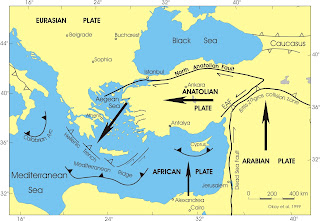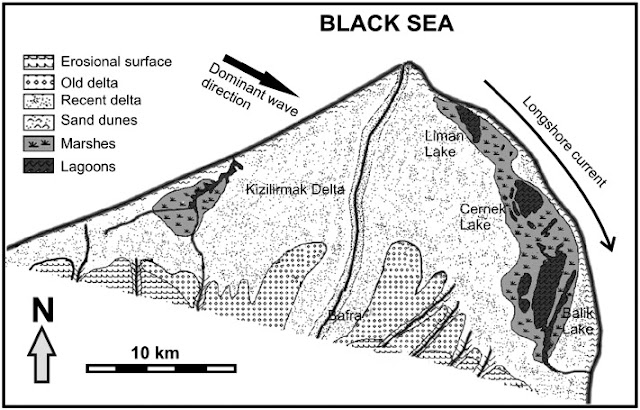Tectonic Plates and Fault Zones of Turkey
Tectonic Plate Map of Turkey
Turkey is is vulnerable to many natural hazards. The country's primary natural hazards are earthquakes, landslides and floods.
Turkey is bordered on the north by the North Anatolian Fault Zone (NAFZ), which forms the boundary between the Anatolian plate, and the Eurasian plate to its north.
The Anatolian Plate encompasses the entire country of Turkey, stretching eastward across the country for nearly 750 miles (900 km). The NAFZ is a continental transform fault. This fault interlocks with the Eurasian fault as it moves to the west.
Turkey is bounded on the east by the East Anatolian Fault Zone (EAFZ), which separates the Anatolian plate from the Arabian plate, on the border between Turkey and Syria. This area, according to N. Turkelli, et al, in Seismic Zones in Eastern Turkey, "...is one of the youngest continent-continent collision zones on earth, where the Arabian plate collides with the Eurasian plate to form the Turkish-Iranian plateau, causing movement along the North and East Anatolian fault zones."
The western portion of the NAFZ is estimated to have existed for 8 million years. Here, the earthquakes, historically, have not exceeded Magnitude 7.5, due to the (relative) "immaturity" of the zone. In the eastern section of the NAFZ, however, the area is older - an estimated 12-13 million years - and therefore, earthquakes of Magnitude 8, or greater, can occur on this older portion of the fault zone.
This latter information, reinforces what Marco Bohnhoff, et al. referenced, in Technophysics (2016), which states that, "The magnitude of the earthquake scales with the maturity of the fault," according this new study.
Armed with this ground-breaking (pardon the pun!) information, disaster management officials, working with scientists, now have new knowledge with which to more accurately project where major tectonic shifts might occur, and plan accordingly to mitigate potential hazards along these seismically active areas, reducing the loss of life and property damage.
REFERENCES:
Marco Bohnhoff, et al. (2016) Technophysics, DOI:10.1016/j.tecto.2016,02.028.
Online: http://atlas.geo.cornell.edu/turkey/seismiczonesineasternturkey,
Centres.
Internet: www.gfdrr.org, Global Facility for Disaster Reduction and Recovery.



Fantastic entry about tectonics and great and clear map [thank you for that]. I guess it is clear where you'll have most issues with earthquake hazards when you discuss this next week...
ReplyDelete